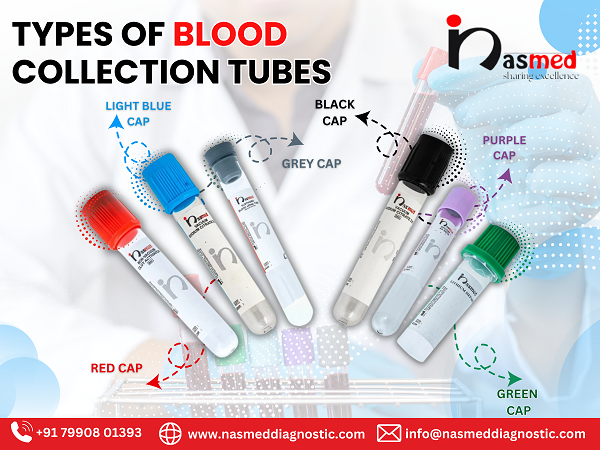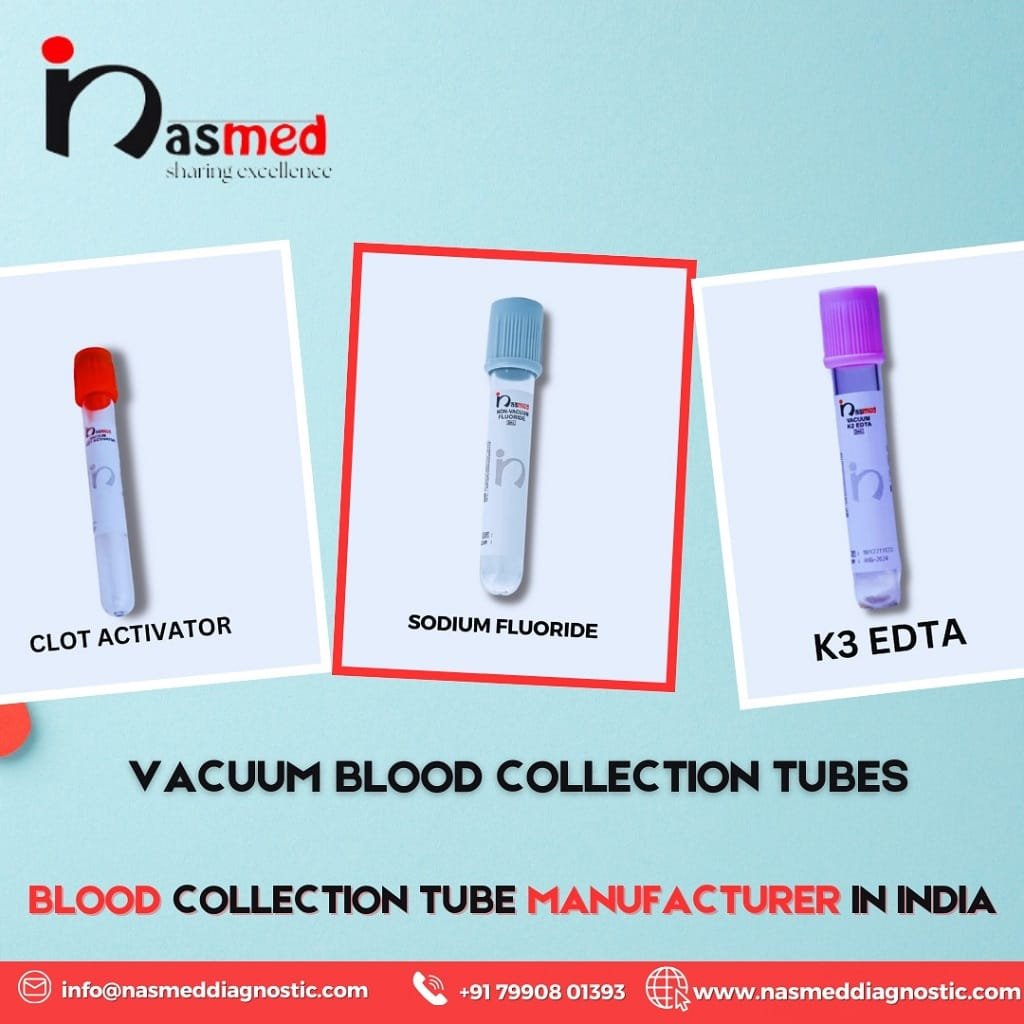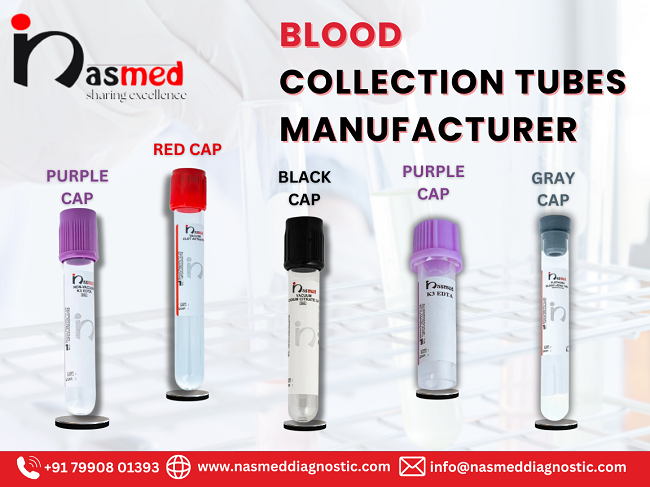Nasmed Diagnostics Pvt. Ltd. offers a range of Types of Blood Collection Tubes: Vacuum Blood Collection Tubes for efficient sample collection with minimal contamination, Non-Vacuum Tubes for manual collection, Micro/Pediatric Tubes for small blood volumes, and Cell-Free DNA Tubes for plasma DNA extraction. These tubes ensure accurate, reliable results for both diagnostic and research purposes.
Comparison of Blood Collection Tubes:
| Type | Volume Required | Applications | Advantages |
| Vacuum Tubes | Standard volumes | Routine and specialized testing | Accurate, efficient, and sterile |
| Non-Vacuum Tubes | Varies | Small-scale or backup testing | Cost-effective, versatile |
| Micro/Pediatric Tubes | Minimal | Neonatal and point-of-care testing | Minimizes patient discomfort |
| Cell-Free DNA Tubes | Standard volumes | Genetic and cancer diagnostics | Preserves cfDNA for advanced testing |
1. Vacuum Blood Collection Tubes
Clinicians widely use vacuum blood collection tubes in clinical settings for their convenience and efficiency. Pre-evacuated tubes create a vacuum that automatically draws a set amount of blood when the needle inserts.
Features of Vacuum Blood Collection Tubes:
- Pre-Evacuated Design: The vacuum inside the tube ensures consistent and precise blood collection.
- Additives: Vacuum tubes may contain anticoagulants, clot activators, or gel separators depending on the intended use.
- Color-Coded Caps: The manufacturer color-codes the caps to indicate the type of additive present, simplifying the identification process.
- Sterility: These tubes are sterile, reducing the risk of contamination.
Common Uses:
- Routine Blood Tests: Vacuum tubes are ideal for complete blood counts (CBC), metabolic panels, and liver function tests.
- Specialized Testing: Laboratories use tubes with additives like EDTA or heparin for specialized analyses, such as coagulation and genetic testing.
Advantages:
- Easy to use and time-efficient.
- Reduces the risk of underfilling or overfilling.
- Minimizes handling errors.
2. Non-Vacuum Blood Collection Tubes
Non-vacuum blood collection tubes are an alternative to vacuum tubes, often used in smaller medical practices or laboratories. The healthcare professional relies on gravity to fill these tubes after drawing blood with a syringe.
Features of Non-Vacuum Blood Collection Tubes:
- Manual Filling: A healthcare professional transfers blood manually from a syringe into the tube.
- Additives: Like vacuum tubes, these may contain anticoagulants or other substances.
- Versatility: Suitable for smaller blood sample volumes.
- Cost-Effective: Generally less expensive than vacuum tubes.
Common Uses:
- Small-Scale Laboratories: Often used in clinics where blood volume requirements are minimal.
- Backup Collection: Useful in situations where vacuum tubes are unavailable.
Advantages:
- Ideal for controlled blood transfer.
- Reduces wastage in scenarios requiring minimal blood samples.
- Offers flexibility in sample handling.
3. Micro/Pediatric Tubes
Designers create micro or pediatric blood collection tubes for minimal blood draws in neonates, infants, and patients with difficult venous access.
Features of Micro/Pediatric Tubes:
- Small Volume: Requires only a few drops of blood.
- Additives: Available with or without additives, depending on the test.
- User-Friendly Design: Often equipped with narrow openings to minimize sample loss.
Common Uses:
- Neonatal Care: Used for newborn screenings and tests.
- Point-of-Care Testing: Suitable for glucose monitoring, hematocrit levels, and other bedside diagnostics.
- Research: Used in studies with limited sample availability.
Advantages:
- Minimizes discomfort and trauma for pediatric patients.
- Reduces blood volume loss, which is critical for infants.
- Compatible with automated analyzers.
4. Cell-Free DNA Tubes
Designers create cell-free DNA (cfDNA) tubes to preserve circulating cell-free DNA in blood samples. These tubes play a crucial role in liquid biopsies and genetic testing.
Features of Cell-Free DNA Tubes:
- Stabilizing Additives: Contain preservatives that prevent the degradation of cfDNA.
- Extended Stability: Maintains sample integrity for up to several days at room temperature.
- Leak-Resistant Design: Ensures secure sample transport.
Common Uses:
- Prenatal Testing: Non-invasive prenatal testing (NIPT) to detect fetal genetic abnormalities.
- Cancer Diagnostics: Liquid biopsies for identifying tumor markers and genetic mutations.
- Transplant Monitoring: Assessing organ transplant rejection through donor-derived cfDNA.
Advantages:
- Preserves cfDNA for accurate analysis.
- Eliminates the need for immediate processing.
- Enables non-invasive diagnostic testing.
Choosing the Right Blood Collection Tube
Selecting the appropriate blood collection tube depends on various factors, including the type of test, patient population, and laboratory requirements. Here are some tips to guide the selection process:
- Identify the Test Requirements: Check whether the test requires an anticoagulant, clot activator, or gel separator.
- Consider Patient Needs: Use micro tubes for pediatric patients or those with limited venous access.
- Ensure Compatibility: Confirm that the tube is compatible with the laboratory’s processing equipment.
- Handle with Care: Follow manufacturer guidelines for proper handling and storage to maintain sample integrity.
Conclusion:
Blood collection tubes play a crucial role in modern healthcare and research. Designers create vacuum, non-vacuum, micro, and cell-free DNA tubes for specific functions, offering unique benefits. Understanding the features, uses, and advantages of each tube ensures accurate diagnostics and better patient outcomes. To maintain the integrity of blood samples and achieve reliable results, it’s essential to choose the right tube for each task. For quality and precision in blood collection, Nasmed Diagnostics Pvt. Ltd. provides a wide range of trusted blood collection solutions to support healthcare professionals in delivering optimal patient care.



